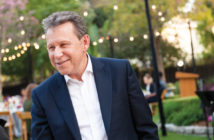View from 305: Thoughts from the President’s Office
When I moved back to the West Coast in 2012, I was initially taken aback by the amount of attention the media devoted to the entertainment “business.” Serious issues of national politics, world news, and social trends received comparatively short shrift next to what I perceived as the superficial glitz and gossip of Hollywood.
Yet I came to realize that “Hollywood” is complex, important, and not confined to that city an hour west of Redlands. It is a vast industry that has a serious and much broader reach and impact than I, or indeed many of us, can easily see. Its reach is far beyond the consumer’s experiential perspective of cinema and television. According to the 2015 Otis Report on the Creative Economy, the California entertainment industry is worth $104.4 billion annually (including direct, indirect, and induced effects) and provides, directly or indirectly, approximately 323,000 jobs. Some 243,000 of these are in Los Angeles and Orange Counties. This translates into professional opportunities for our students and alumni, as well as a rich cultural backdrop for our campuses. For some students and alumni, the proximity of Los Angeles also means the chance to pursue a passion—often sparked by their experiences at the University of Redlands—for telling important stories, creating transcendent music, or illuminating the human experience.
Also contrary to newspaper impressions, the entertainment industry can be about much more than the quest for fame. It can represent the opportunity to engage in creative pursuits and strive for mastery of a chosen artistic discipline. It can be a platform to amplify one’s voice.
Fame is ephemeral. I have had my own fleeting moments of seeming fame. In my office, I have a picture of myself receiving a check for $1.3 million from Cal Ripken Jr. on the pitcher’s mound at Oriole Park at Camden Yards the night he broke “Iron Man” Lou Gehrig’s record for most consecutive games played. The check was for my research lab after our discovery related to Lou Gehrig’s disease. You can pick out Joe DiMaggio and Frank Robinson … and, in the back, there’s Ralph. Two of the journal articles written on our scientific work were held up as “citation classics.” But few people probably read them beyond two reviewers, a bunch of neurologists, and my father and mother! Fame? Not really. Fulfillment, yes.
In creative careers, when fame does come, it’s often after a winding path filled with apparent detours—much like the path of exploration that a broad, liberal education offers inquisitive students. An old example is Antonio Vivaldi, who was first trained and ordained as a priest but left that calling when he was appointed “maestro of violin” at Ospedale della Pieta, a Venetian orphanage for girls. In essence, his job was to give violin lessons to 14-year-old orphans. But, thanks to that position, he went on to write 550 concertos, including The Four Seasons. Did he seek merely creative fulfillment, or fame? He achieved both by pursuing only the former.
In the cover story of this issue, I am heartened to read about many University of Redlands alumni working in film, television, stage, the concert hall, and emerging media telling of their journeys in pursuit of creative meaning, not fame. Mike Ajakwe Jr. ’87, for one, has followed a love of screenwriting, which he first discovered at Redlands, through twists and turns involving a night job and the birth of a new creative medium—the internet. Echoing some of my sentiments about Hollywood, he advises aspiring writers to be in the business for the “right reasons.”
As a believer in the power of both liberal arts and professional education, I am not surprised that the University has also played a role in advancing the careers of those on the business side of the industry. Shavonne Wieder ’10 built on her MBA from the Burbank campus, and Julie Gladders Henderson ’92 on her Johnston undergraduate education, to thrive within this dynamic sector, which encompasses not only marketing and public relations but also legal, technical, accounting, and many other types of careers.
The supportive nature of the University of Redlands community also shines through in these stories. We hear about life-changing mentoring by music, English, and theatre faculty. We see enduring friendship and support among peers, like designers Haley Keim ’10 and Tanya Apuya ’08. And we learn how alumni, including actor-author Eric Pierpoint ’73 and actor-singer-comedian Scott Palmason ’04, return to the University to share their talents and experience with the next generation of Redlands students.
I am proud to be a member of this vibrant, productive U of R community with its extensive alumni family, and I wish you the utmost success in pursuit of your own brand of creativity and deep fulfillment, whether or not it ever leads to that ephemera we call fame.
With warmest regards,
Ralph W. Kuncl, PhD MD
President
University of Redlands




